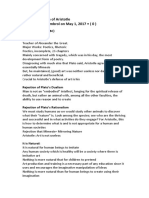0% found this document useful (0 votes)
64 views4 pagesPoetics
Aristotle's concept of mimesis in *Poetics* suggests that art imitates life, allowing artists to interpret and represent human experiences, emotions, and actions. He also discusses catharsis, the emotional cleansing that audiences experience through tragedy, which evokes feelings of pity and fear, ultimately leading to a sense of relief. Additionally, Aristotle outlines six essential elements of tragedy—plot, character, thought, diction, melody, and spectacle—that contribute to the emotional impact and effectiveness of tragic drama.
Uploaded by
dipessamanta21Copyright
© © All Rights Reserved
We take content rights seriously. If you suspect this is your content, claim it here.
Available Formats
Download as PDF, TXT or read online on Scribd
0% found this document useful (0 votes)
64 views4 pagesPoetics
Aristotle's concept of mimesis in *Poetics* suggests that art imitates life, allowing artists to interpret and represent human experiences, emotions, and actions. He also discusses catharsis, the emotional cleansing that audiences experience through tragedy, which evokes feelings of pity and fear, ultimately leading to a sense of relief. Additionally, Aristotle outlines six essential elements of tragedy—plot, character, thought, diction, melody, and spectacle—that contribute to the emotional impact and effectiveness of tragic drama.
Uploaded by
dipessamanta21Copyright
© © All Rights Reserved
We take content rights seriously. If you suspect this is your content, claim it here.
Available Formats
Download as PDF, TXT or read online on Scribd
/ 4






















































































